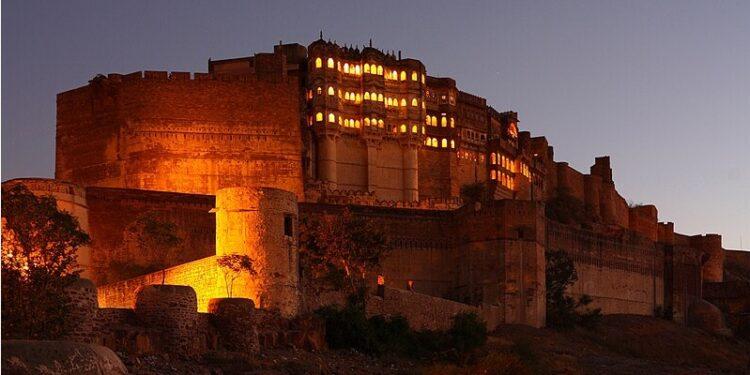Best Places To Visit In Rajasthan, a dynamic and culturally diverse state in western India, has several captivating locations that provide a window into its regal past and magnificent buildings. The Pink City of Jaipur, known for its breathtaking buildings like the Hawa Mahal and the City Palace, is one of the must-see locations. Jodhpur, often known as the Blue City, enthrals tourists with its vivid blue buildings arranged around the imposing Mehrangarh Fort. The City of Lakes, Udaipur, captivates visitors with its serene lakes, palaces, and the famous Lake Palace, which appears to float on Lake Pichola.
Jaisalmer invites with its architecture of golden sandstone, especially its beautifully carved havelis and powerful Jaisalmer Fort, for a trip back in time. Pushkar is a spiritual retreat that is home to the energetic Pushkar Camel Fair, as well as a revered lake and the well-known Brahma Temple. For those who love the outdoors, Ranthambore National Park is a paradise because of its abundant wildlife and opportunities to see magnificent tigers. Travellers looking for an immersive experience in India’s regal past can find a treasure mine of historical, cultural, and scenic destinations in Rajasthan.
Why Should You Choose Best Places To Visit In Rajasthan?
Rich Cultural Heritage: Rajasthan is well known for its ingrained cultural heritage, which features an exquisite fusion of art, history, and customs. In addition to being architectural wonders, the state’s palaces, forts, and temples tell stories of a bygone era.
Architectural Wonders: The state is home to some of the most breathtaking examples of architectural architecture, including as the magnificent Mehrangarh Fort in Jodhpur, the exquisite City Palace in Udaipur, and the carefully planned Hawa Mahal in Jaipur. By investigating these buildings, tourists can see the magnificence of Rajput design.
Distinctive Scenes: Travellers are enthralled by Rajasthan’s varied landscapes. From the gorgeous lakes of Udaipur to the golden sands of the Thar Desert in Jaisalmer, every location offers a unique and spectacular landscape, making for a well-rounded travel experience.
Cultural Events: Throughout the year, Rajasthan holds a number of bright and colourful events, such the Pushkar Camel Fair and the exuberant Holi celebrations in Jaipur. Taking part in these celebrations offers an opportunity to witness the state’s diverse cultural fabric up close.
Wildlife Encounters: Ranthambore National Park offers a chance for nature lovers to see a variety of wildlife, including the magnificent Bengal tiger. This park’s wildlife safaris provide an exciting and different experience that will add adventure to your Rajasthan itinerary.
Warmth & Hospitality: The people of Rajasthan are renowned for their warm hospitality, and they extend a warm welcome to guests. A personal touch is added to your tour by staying in heritage hotels and connecting with the amiable people of Rajasthan.
Culinary Delights: With a wide variety of flavours and spices, Rajasthani cuisine is a feast for the senses. Food in the area is a culinary excursion in and of itself, from the well-known Dal Baati Churma to the delicious Rajasthani sweets.
Shopping Extravaganza: Traditional handicrafts, textiles, jewellery, and souvenirs may be found in plenty in Rajasthan’s busy marketplaces, like Johari Bazaar in Jaipur and Sardar Market in Jodhpur. These markets enable visitors to bring a bit of the state’s colourful culture home with them.
Here Is List of The Best Places In Ahmedabad
- Jaisalmer
- Udaipur
- Bundi
- Jaipur
- Ranthambore
- Jain temple
- Mount Abu
- Pushkar
- Ranakpur
- Ajmer
- Bharatpur
- Bikaner
- Brahma Temple
- Hawa Mahal
- Jantar Mantar
- Jodhpur
- Lake Pichola
- Mehrangarh Fort
- Keoladeo National Park
- Sheesh Mahal
- Amber Palace
- Bhangarh Fort
- Chittorgarh
- Neemrana
- Alwar
- Kumbhalgarh
- Shekhawati
- Garadia Mahadev
- Nathdwara
- Fatehpur
30 Best Places To Visit In Rajasthan
1.Jaisalmer (Best Places To Visit In Rajasthan)
Known as the “Golden City,” Jaisalmer is a captivating location in the centre of Rajasthan, India. Jaisalmer, a city well-known for its breathtaking architecture, extensive history, and lively culture, has many intriguing sites to discover. The Jaisalmer Fort, a UNESCO World Heritage Site that rises majestically from the golden dunes, is without a doubt the jewel in the crown of this desert city. Inside its boundaries, tourists can meander through little pathways decorated with gorgeous havelis, or traditional houses, such as Salim Singh Ki Haveli and Patwon Ki Haveli, which have amazing craftsmanship and elaborate carvings.

The intricate Jain Temples within the fort are also a testament to the city’s religious diversity. Additionally, the Sam Sand Dunes beckon adventure seekers to experience the allure of the Thar Desert with camel safaris and breathtaking sunset views. The Gadisar Lake, with its serene surroundings and historic temples, provides a tranquil escape. Jaisalmer offers a unique blend of history, architecture, and natural beauty, making it an enchanting destination for travelers seeking an authentic Rajasthan experience.
2.Udaipur
Rajasthan’s regal appeal is evident at Udaipur, which is commonly referred to as the “City of Lakes” and is tucked away amid the gorgeous Aravalli Range. The stunning City Palace, an architectural wonder that looks out over the placid waters of Lake Pichola, is the crown gem of Udaipur. The palace complex offers stunning views of the surroundings and features a blend of Mughal and Rajasthani architectural styles. Romantic boat cruises to the famous Jag Mandir and Jag Niwas, also known as the Lake Palace, which appears to float on the glittering waters, are scattered across Lake Pichola itself.

The Jagdish Temple’s exquisite mirror work and elaborate carvings demonstrate the city’s artistic ability. The Garden of the Maidens, also known as Saheliyon Ki Bari in Udaipur, is a tranquil haven with fountains, kiosks, and marble elephants. The colourful streets and busy bazaars of Udaipur’s old city exude a vintage charm that contrasts delightfully with the city’s regal grandeur. With its lavish palaces, tranquil lakes, and romantic atmosphere, Udaipur entices visitors to see the magnificence of Rajasthan’s cultural diversity.
3.Bundi
Tucked away in Rajasthan’s untamed hills, Bundi is a hidden treasure that provides a tranquil diversion into the historical and architectural marvels of the region. Overlooked by the majestic Taragarh Fort, this quaint village with its step wells, old palaces, and blue-painted homes has an old world appeal. Views of the town and its environs are expansive from the hilltop Taragarh Fort. Within the fort complex, the elaborately decorated Bundi Palace is a monument to the creative sophistication of the area. Bundi’s step wells, especially the magnificent Raniji ki Baori, which has excellent carvings and a serene atmosphere, are one of its distinctive attractions.

The elaborate Chitrashala, also known as the Ummed Mahal, enthrals tourists with its exquisitely restored murals that portray historical and mythical scenes. The town’s colourful bazaars and winding alleyways contribute to its vintage charm, making it a wonderful travel destination for Rajasthan visitors looking for something off the beaten road. Bundi welcomes visitors to experience its rich tapestry of culture and legacy through its architectural wonders, historic charm, and inescapable sense of nostalgia.
4.Jaipur
Rajasthan’s capital city, Jaipur, is a bustling, culturally diverse travel destination that perfectly captures the state’s royal heritage. Jaipur, sometimes referred to as the “Pink City” because of the unusual pink hue of its architecture, has many fascinating sites to discover. The beautiful Hawa Mahal is a famous representation of Jaipur’s architectural magnificence, with its delicately carved windows arranged in a honeycomb pattern. A large complex of palaces, courtyards, and gardens, the City Palace displays a fusion of Rajput and Mughal architecture and provides an insight into the luxurious way of life of the former kings. A collection of 18th-century astronomy instruments at the UNESCO World Heritage Site Jantar Mantar showcases Jaipur’s advances in science and culture.
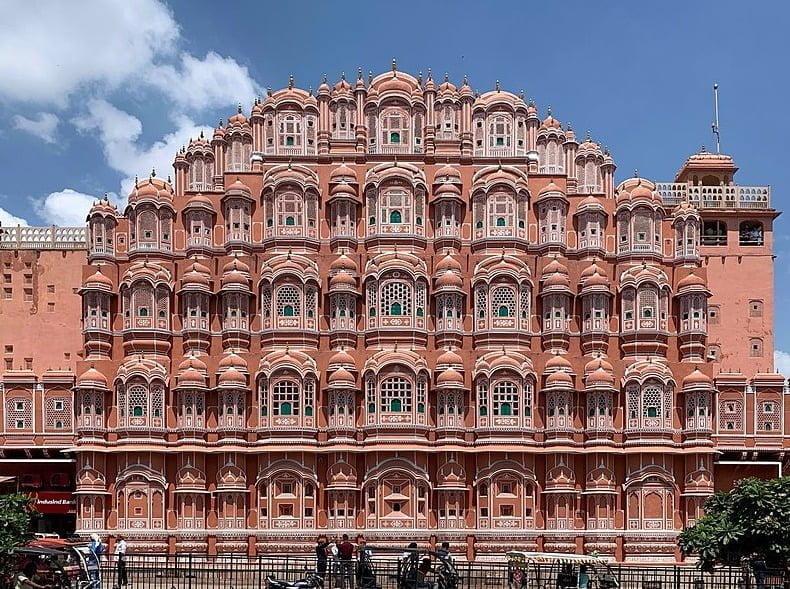
Perched atop a hill, Amer Fort is a magnificent stronghold whose elaborate architecture and expansive views of the surroundings enthral. Jaipur is renowned for its lively bazaars, such as the Johari and Bapu bazaars, where guests can get lost in the vivid hues of Rajasthani handicrafts, jewellery, and textiles. Jaipur is a mesmerising place that skilfully combines history and modernity, with its imperial palaces, vibrant markets, and forts.
5.Ranthambore (Best Places To Visit In Rajasthan)
South-east Rajasthan’s Ranthambore is a wildlife enthusiast’s dream come true and among the best locations in the state to take in the unadulterated splendour of the natural world. The Ranthambore National Park, a vast animal refuge that was formerly a hunting site for Maharajas, is the jewel in this region’s crown. The park, which is well-known for having a healthy population of Bengal tigers, provides a rare chance for wildlife safaris that let guests see these magnificent animals in their native environment. Ancient ruins dot the Ranthambore landscape, chief among them the Ranthambore Fort, which gives the wildlife sanctuary a historical and architectural element. For those who enjoy the outdoors, the mix of verdant lakes, thick forests, and a wide variety of plants and animals makes an enthralling setting.
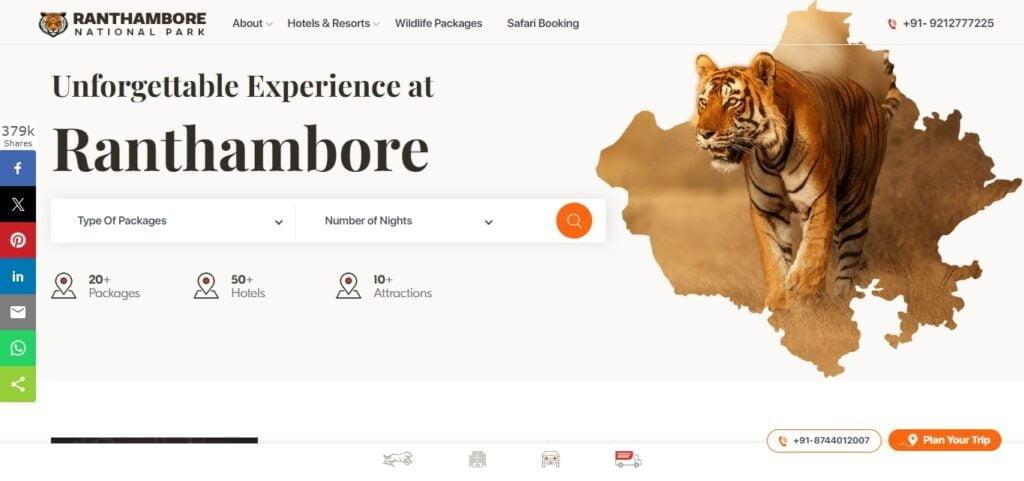
Ranthambore is home to a wide range of wildlife, including crocodiles, leopards, sloth bears, and several bird species. It is not just about tigers, though. The Surwal Lake and Padam Talao, which are close by, add even more to the area’s beautiful appeal. Ranthambore is a monument of Rajasthan’s many attractions, where the natural and historical treasures of this amazing state coexist peacefully with the wildness.
6.Jain temple
Rajasthan is a state full with architectural treasures, but the Jain temples that are dotted all over the place are particularly noteworthy as magnificent displays of both creative and religious genius. In particular, the Dilwara Temples in Rajasthan’s hill station of Mount Abu are well known for their exquisite marble sculptures and breathtaking architecture. These temples, which are devoted to the Jain Tirthankaras, are known as some of the most exquisite Jain temples in the world because of their exceptional craftsmanship. The attention to detail and expertise of the artisans who created these temples over a millennium ago are evident in the beautifully carved pillars and elaborate ceilings seen throughout the marble surfaces.
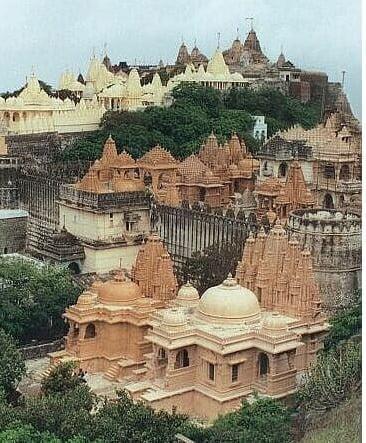
Situated in the Aravalli Range, the Ranakpur Jain Temple is another noteworthy location. This magnificent complex of temples features 1,444 exquisitely carved pillars, each with a distinct design, making it an enchanting exhibition of marble architecture. Because of the exquisite and delicate artistry of Jain temples, these locations serve as both religious as well as cultural and historical landmarks that add to Rajasthan’s rich historical tapestry. A spiritual and artistic journey showcasing the everlasting grandeur of Rajasthan’s cultural past is provided to visitors to these Jain temples.
7.Mount Abu
Mount Abu is a tranquil haven in Rajasthan’s parched terrain, tucked away in the lovely Aravalli Range. Mount Abu, the lone hill station in the state, is well-known for its mild environment, verdant surroundings, and breathtaking views. It provides a rejuvenating getaway. The jewel in the crown of Mount Abu is the Dilwara Temples, an architectural wonder from the 11th and 13th centuries. These temples honouring the Jain Tirthankaras are well-known for their exquisite marble sculptures and magnificent craftsmanship, drawing tourists with their spiritual and aesthetic appeal. Located in the centre of the town, Nakki Lake is a peaceful area encircled by hills and folklore.
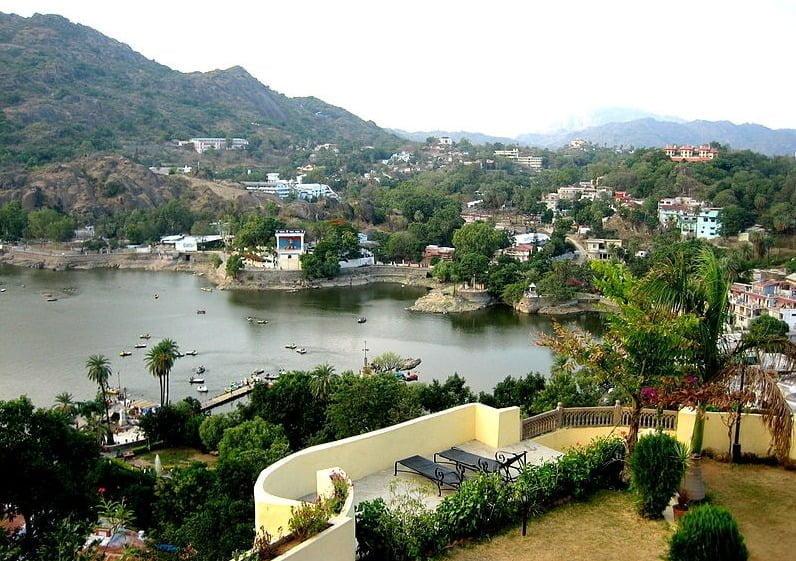
Nakki Lake boating provides a peaceful experience that lets guests appreciate the beauty of the surroundings. The highest point in the Aravalli Range, Guru Shikhar, is a must-visit location to see the expansive vistas of the surrounding plains. Other attractions that highlight Mount Abu’s visual attractiveness are the eco-friendly Bailey’s Walk and the sunset location at Honeymoon Point. Mount Abu is a very interesting place in Rajasthan because of its unusual combination of natural beauty, historic buildings, and cool weather.
8.Pushkar
The town of Pushkar is a unique and spiritually charged location in the heart of Rajasthan, nestled around the holy Pushkar Lake. Pushkar is well-known for its yearly Camel Fair, which attracts tourists and traders from all over the world and provides a lively cultural experience. One of the rare temples in the world devoted to Lord Brahma, the Brahma Temple is an important place of pilgrimage. Both tourists and devotees are drawn to it by its beautifully carved marble building and crimson spire. Ghats encircle Pushkar Lake, where visitors conduct ceremonies and ceremoniously immerse themselves in the sacred waters.
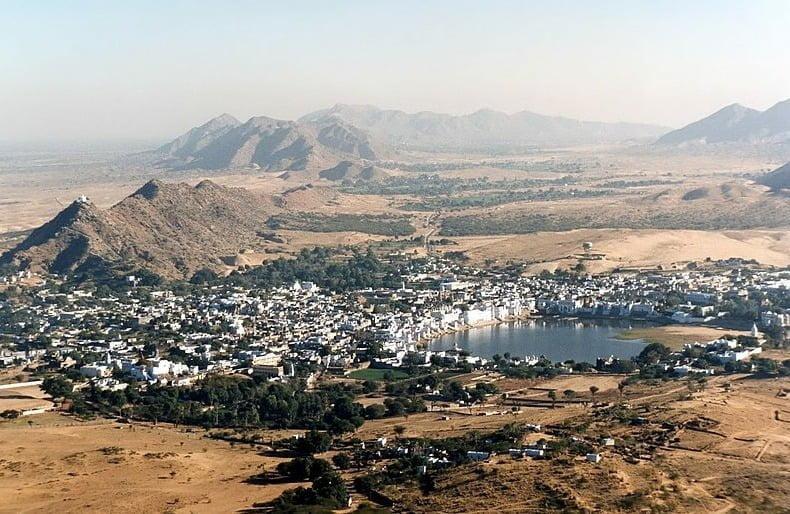
Pushkar’s colourful bazaars, which provide a wide selection of Rajasthani handicrafts, jewellery, and textiles, contribute to the town’s allure. The Savitri Temple is a well-liked destination for both religious and casual visits because of its hilltop location and expansive views of the tranquil surroundings. Pushkar is a must-visit location for everyone looking for a singular and immersive experience in the captivating state of Rajasthan because of its spiritual atmosphere, which is enhanced by its cultural liveliness and beautiful surroundings.
9.Ranakpur
Nestled in the picturesque Aravalli Range in Rajasthan, the serene town of Ranakpur is well-known for its remarkable architectural structure, the Ranakpur Jain Temple. One of the most important Jain pilgrimage sites is this elaborate temple, which is devoted to Adinatha, the first Tirthankara of Jainism. It is a masterwork of marble craftsmanship. The temple, which dates back to the fifteenth century, is distinguished by its 1,444 finely carved marble pillars, each of which is decorated with an excellent pattern. Ranakpur Jain Temple’s intricate design and precise architecture are proof of the Marwari artists’ mastery in their craft.
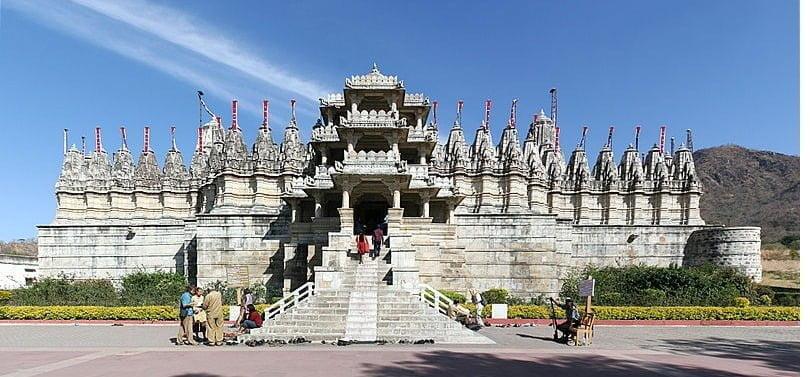
Nestled in a remote valley and surrounded by verdant vegetation, the temple complex exudes a serene and spiritually serene aura. Past the temple, Ranakpur presents a scenic environment with neighbouring landmarks such as the Ranakpur Dam and the Surya Narayan Temple. Ranakpur’s breathtaking natural surroundings and architectural ingenuity combine to create an alluring travel destination that encourages visitors to take in Rajasthan’s rich cultural legacy.
10.Ajmer (Best Places To Visit In Rajasthan)
Travellers find Ajmer, which is in the centre of Rajasthan, to be an enticing location due to its historical and religious significance. Visitors of all faiths are drawn to the well-known Ajmer Sharif Dargah, a Sufi shrine devoted to the venerated saint Moinuddin Chishti. The qawwali melodies and the elaborate architecture of the Dargah complex create a spiritual atmosphere. With its commanding position above the city, the Taragarh Fort provides sweeping views of both the Ana Sagar Lake and Ajmer. The lake itself makes for a charming location for calm boat excursions and strolls along the promenade.
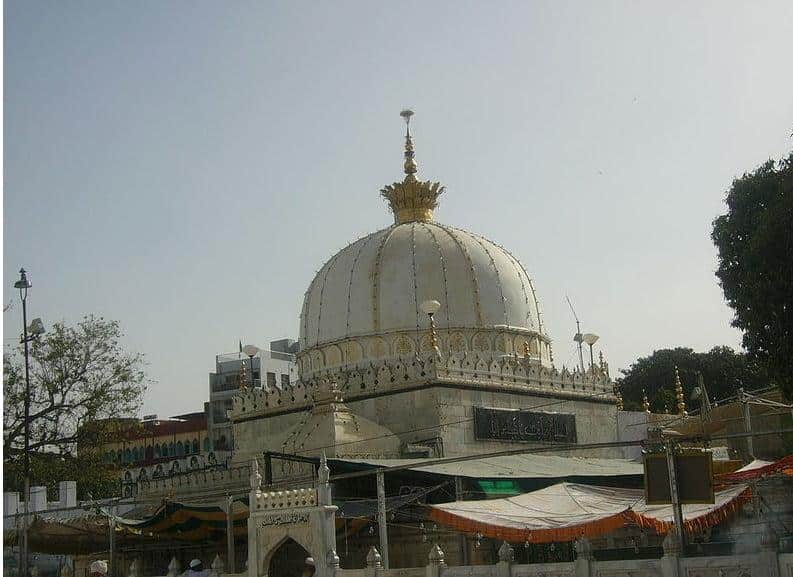
Exhibitions of Mughal and Rajput artefacts at the Akbari Fort and Museum offer a window into the history of the area. Near Ajmer, Pushkar is a holy town that is well-known for its Brahma Temple and yearly camel carnival. It’s a wonderful side trip from Ajmer. Ajmer offers visitors to Rajasthan’s varied landscapes a singular and rewarding experience by skilfully fusing the religious with the historical.
11.Bharatpur
Known as the “Eastern Gateway to Rajasthan,” Bharatpur is a picturesque city renowned for its historical significance and abundant bird diversity. A sanctuary for avian aficionados, Keoladeo National Park (previously known as the Bharatpur Bird Sanctuary) is recognised as a UNESCO World Heritage Site. For ornithologists and lovers of the great outdoors, the park is a haven for migratory birds, home to Siberian cranes among many other species. With its robust construction and antiques, the Lohagarh Fort, sometimes referred to as the Iron Fort, is a testament to Bharatpur’s regal heritage. Within the fort complex, the Government Museum provides an insight into the cultural legacy of the area.
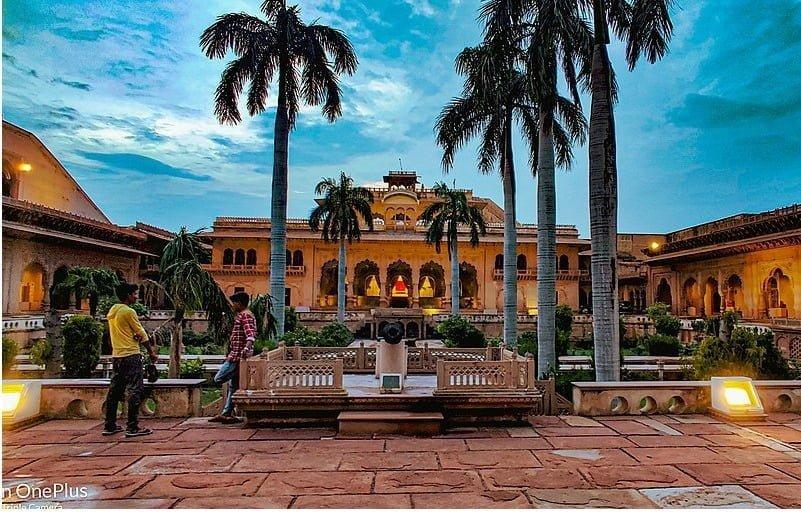
The Bharatpur Palace, which combines Mughal and Rajput architectural elements and is embellished with exquisite murals and carvings, is another remarkable sight. Bharatpur serves as a starting point for visiting the former princely state of Deeg, whose stunning architecture is showcased by the Deeg Palace and its enchanting water gardens. In the colourful terrain of Rajasthan, Bharatpur offers a delightful fusion of natural beauty and cultural legacy, whether you’re birdwatching in the national park or touring the historical relics.
12.Bikaner
The city of Bikaner, located in north-west Rajasthan, provides a singular fusion of stunning architecture, a thriving cultural heritage, and a long history. A monument to the architectural skill of the Rajput monarchs is the majestic Junagarh Fort, which dates back to the 16th century. The well-preserved interiors, elaborate balconies, and exquisite carvings of the fort offer a fascinating look into Bikaner’s regal history. Nearby Deshnoke is the Karni Mata Temple, famous for its distinct population of rats that believers hold sacred. Another attraction is the Lalgarh Palace, a masterpiece of red sandstone architecture that combines Mughal, Rajput, and European influences.
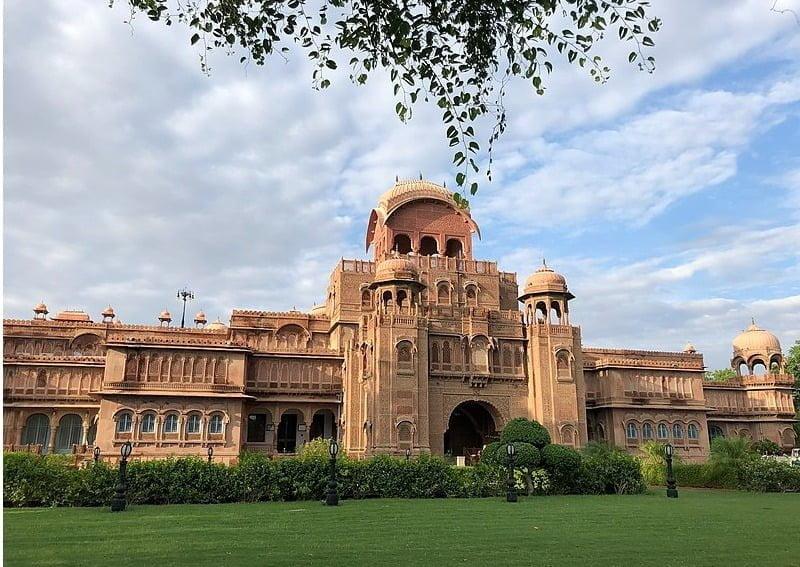
The Old Bikaner town carries tourists back in time to a time of grandeur and splendour with its winding pathways and frescoed havelis. A well-liked activity that lets visitors experience the natural beauty of rural life and explore the surrounding desert landscapes is the Bikaner Camel Safari. Bikaner’s food scene is equally alluring, with regional specialities like rasgulla and bhujia bringing a tasteful element to the city’s cultural fabric. For those looking for a real Rajasthani experience, Bikaner is an intriguing destination due to its unique character and rich cultural heritage.
13.Brahma Temple
Pushkar’s Brahma Temple is one of Rajasthan’s most important tourist destinations since it is a unique and revered wonder. This temple honours Lord Brahma, one of the main Hindu deities, and is located on the banks of the serene Pushkar Lake. A calm and spiritual atmosphere is created by the temple’s characteristic red spire rising against the neighbouring Aravalli hills. It is the only temple in the world devoted to Lord Brahma, and both devotees and tourists find great religious value in it. The four faces on the idol of Lord Brahma, which represents the four Vedas, are located in the inner sanctum of the temple.
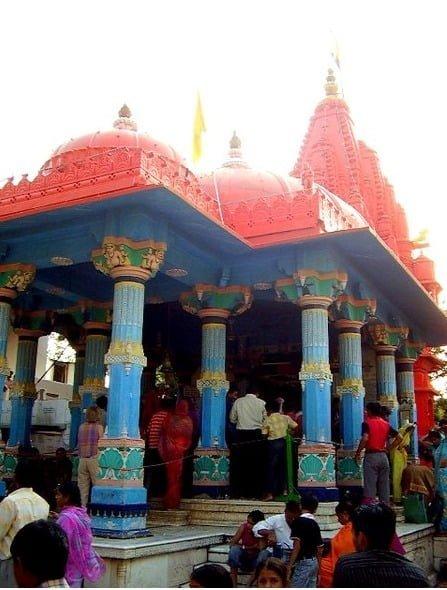
The ornate architecture, silver coins, and marble flooring all contribute to the place’s sanctity and charm. Every year, the Brahma Temple plays host to the colourful Pushkar Camel Fair, which draws pilgrims, vendors, and travellers from all over the world. Beyond its significance as a place of worship, the temple’s stunning setting and charming architecture make it an alluring travel destination for anybody looking for peace and a vibrant cultural environment in the centre of Rajasthan.
14.Hawa Mahal
The “Palace of Winds,” also known as Hawa Mahal, is a famous architectural marvel that towers over Jaipur, Rajasthan. Built in 1799 by Maharaja Sawai Pratap Singh, this unusual five-story palace is well-known for its elaborate honeycomb exterior including 953 tiny windows, or jharokhas. These windows were primarily installed so that royal women could watch daily activities and celebrations on the streets below without being noticed.
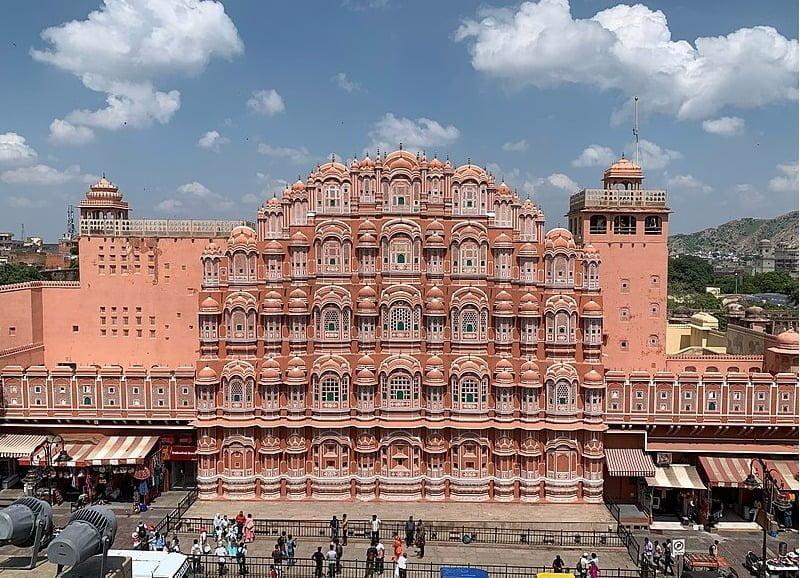
Jaipur’s architectural style is typified by the delicate pink sandstone used in the construction of Hawa Mahal, which has led to the city being dubbed the “Pink City.” The palace, which has domes, arches, and exquisite lattice work, is a magnificent fusion of Rajput and Mughal architectural elements. Within, a museum displays relics and displays that shed light on Jaipur’s past and present. Due to its unusual shape, which gives it the appearance of a crown or honeycomb, Hawa Mahal is a must-visit location for anybody interested in discovering Rajasthan’s cultural and historical riches.
15.Jantar Mantar (Best Places To Visit In Rajasthan)
One of Rajasthan’s most fascinating and important tourist destinations is the astronomical observatory Jantar Mantar, which is located in Jaipur. This UNESCO World Heritage Site, constructed in the early 1700s by Maharaja Sawai Jai Singh II, is a testament to the Maharaja’s love of science and astronomy. One of his five such observatories across North India is the Jantar Mantar in Jaipur. The location is home to a group of nineteen architectural astronomical devices, all of which are intended to provide accurate measurements of sky events. Massive sundials, celestial globes, and devices that precisely predict time, eclipses, and other astronomical events are among the equipment.
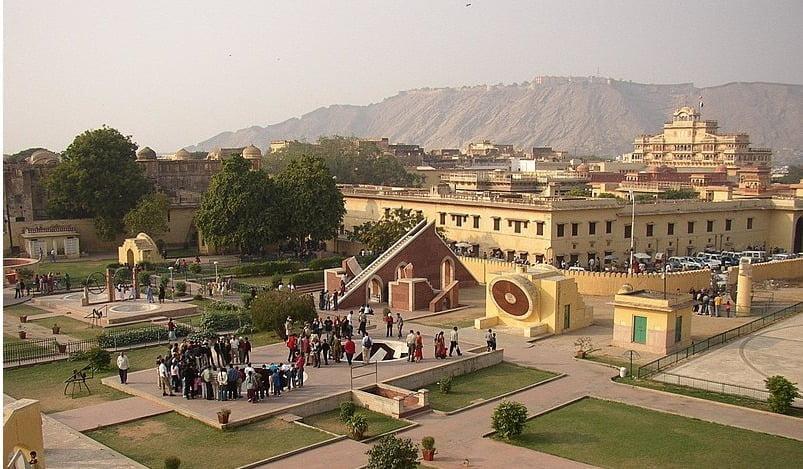
At the centre of Jantar Mantar is the massive Samrat Yantra, the largest sundial in the world, which highlights the observatory’s importance in prehistoric astronomical research. Discover the advanced astronomical knowledge of the Rajput era and marvel at the inventiveness of these instruments when visiting Jantar Mantar. Jantar Mantar is a fascinating location that provides a rare glimpse into the scientific achievements of Rajasthan’s royal legacy for those who are interested in science, history, and architecture.
16.Jodhpur
Jodhpur, often known as the “Blue City” because of the unusual indigo colours of its homes, is a magnificent example of Rajasthan’s architectural and cultural magnificence. Jodhpur, dominated by the massive Mehrangarh Fort perched on a rocky slope, provides sweeping views of both the city and the surrounding Thar Desert. With its elaborately carved panels, large courtyards, and museum housing an extraordinary collection of artefacts, the fort itself is a wonder of Rajput construction. Constructed in honour of Maharaja Jaswant Singh II, the adjacent Jaswant Thada is a revered monument known for its exquisite marble lattice work and serene environs.
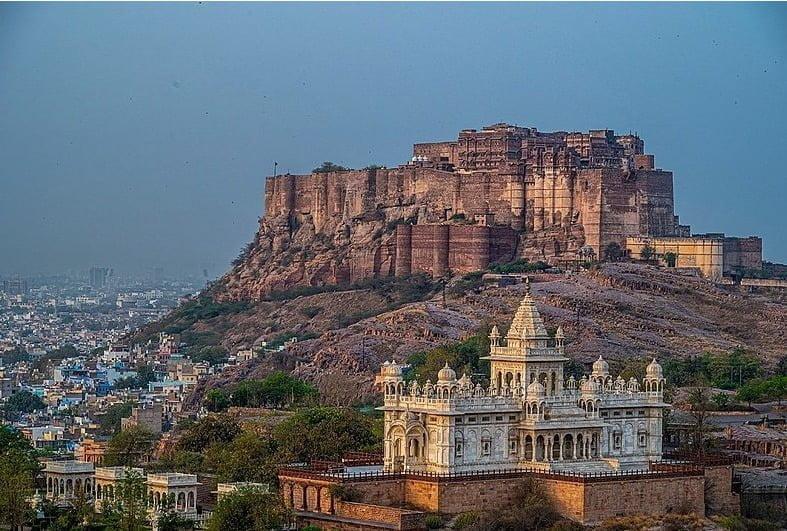
Jodhpur’s lively ambience is exemplified by the clock tower and Sardar Market, located in the city centre, where both residents and visitors enjoy shopping for traditional spices, textiles, and handicrafts. The majestic sandstone Umaid Bhawan Palace is used as a luxury hotel as well as a royal residence. For those looking for an immersive experience in the heart of Rajasthan, Jodhpur is a captivating destination because of its dynamic culture, fascinating historical sites, and friendly locals.
17.Lake Pichola
One of the most calm and magical locations in Rajasthan is Lake Pichola, a charming man-made lake located in the centre of Udaipur. This large lake, which dates back to the 14th century, is encircled by regal mansions, old buildings, and verdant hills, making for an enchanting view. With its stunning white marble architecture set against the Aravalli Range, the historic Lake Palace, now a luxurious hotel, appears to float on the calm waters. Lake Pichola’s regal charm is further enhanced by the expansive complex known as City Palace, which is located on the eastern bank. Visitors can enjoy a mesmerising experience from boat cruises on the lake, which give panoramic views of the surrounding architecture and the magnificent sunset over the city.
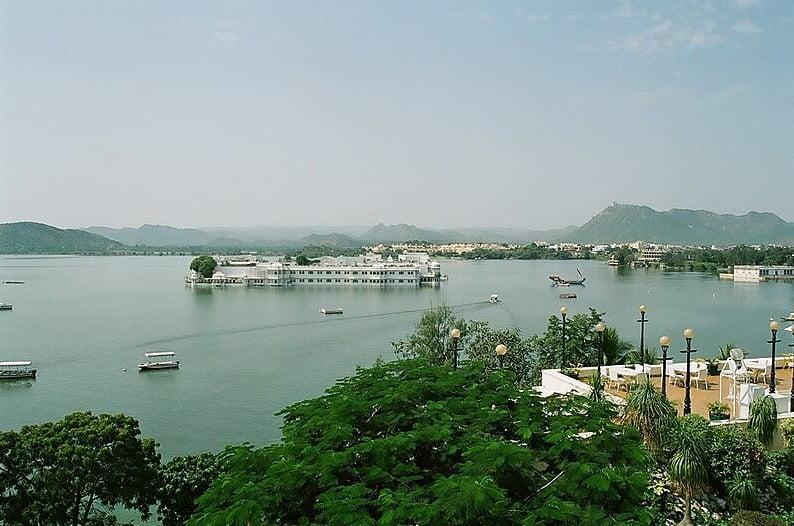
With its finely groomed gardens and artistically planned buildings, the Jag Mandir, an island palace in the middle of the lake, only heightens the attraction. Lake Pichola is a must-visit location for travellers looking for the ideal fusion of natural beauty, history, and culture in the heart of Rajasthan since it perfectly captures the regal and romantic spirit of Udaipur.
18.Mehrangarh Fort
The mighty Mehrangarh Fort, which towers over Jodhpur, is without a doubt one of Rajasthan’s most striking and important historical sites. Rao Jodha, the founder of Jodhpur, constructed the fort on a high hill in the fifteenth century. Its enormous walls provide breathtaking views of the Blue City and the huge Thar Desert. The fort complex’s elaborate palaces, vast courtyards, and elaborate sculptures highlight the Rajput craftsmen’s mastery of both architecture and art. The museum inside the fort offers a thorough understanding of the history of the area by displaying a sizable collection of relics, weaponry, and royal possessions.
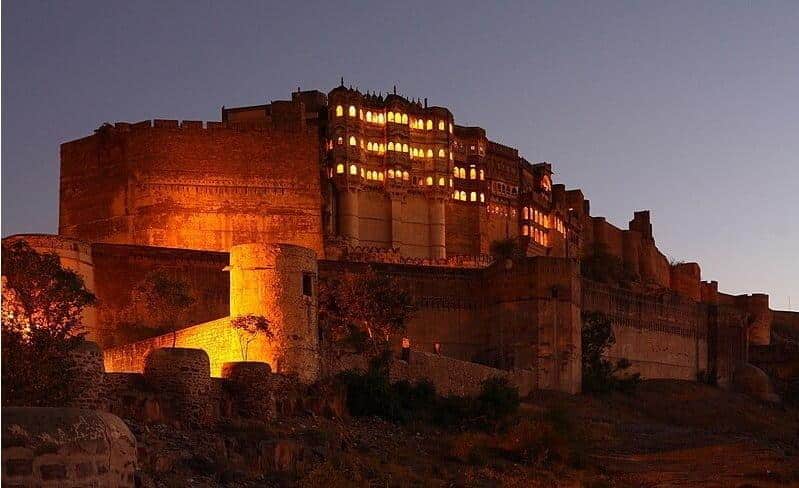
The famous Chamunda Devi Temple, housed inside the fort, gives the historical majesty a spiritual touch. For those looking for an enthralling fusion of history, architecture, and cultural celebrations in the centre of Jodhpur, Mehrangarh Fort is a dynamic and vibrant destination that not only preserves the rich heritage of Rajasthan but also organises cultural events and festivals, like the Rajasthan International Folk Festival.
19.Keoladeo National Park
Keoladeo National Park, often called Bharatpur Bird Sanctuary, is one of Rajasthan’s top wildlife destinations and a lush oasis. This UNESCO World Heritage Site is tucked away in the heart of Bharatpur and was first created as a duck-hunting reserve for the Maharajas of the area. It still serves as an important wetland and bird sanctuary today, drawing a wide variety of resident and migratory bird species. With more than 370 bird species, including the critically endangered Siberian Crane, the park is a birdwatcher’s delight. A variety of species, including deer, pythons, and even the elusive Bengal tiger, are supported by the lush foliage and water bodies in addition to the amazing birdlife.
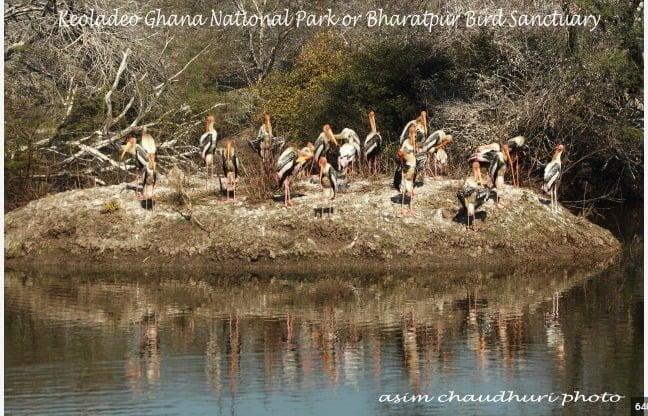
Riding a bike or rickshaw is the greatest method to explore Keoladeo National Park since it allows you to explore the network of routes that wind through the forests and wetlands. The park is one of the must-visit locations in Rajasthan for a singular and immersive encounter with nature because of its peaceful atmosphere and the symphony of bird sounds, which provide a peaceful haven for nature lovers and wildlife enthusiasts alike.
20.Sheesh Mahal (Best Places To Visit In Rajasthan)
The Palace of Mirrors, also known as Sheesh Mahal, is a stunning gem located inside the ancient City Palace complex in Jaipur, Rajasthan. Built in the 18th century under Maharaja Sawai Pratap Singh, the Sheesh Mahal is a stunning example of Rajput royalty’s extravagance and a masterwork of architecture. This palace’s interior is decorated with delicate paintings, elaborate glass mosaics, and detailed mirror work that combine to create an amazing kaleidoscope of colours and patterns. Because of the way the palace is constructed, light can refract through the mirrors, giving the rooms a celestial radiance throughout the day and giving rise to the moniker “Palace of Mirrors.”
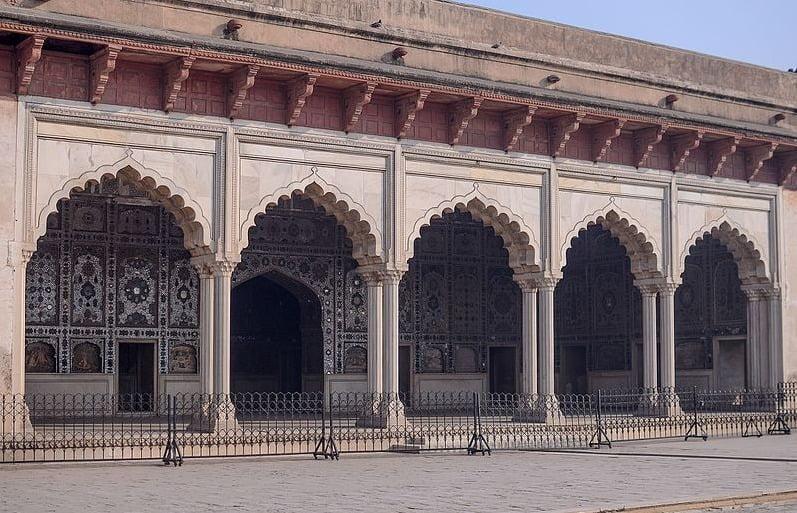
The Sheesh Mahal is a reflection of the obsession the age had with luxury and aesthetic grandeur, as well as the artistic prowess of Rajasthani craftsmen. The Sheesh Mahal at Jaipur’s City Palace is one of the most remarkable sights in Rajasthan that provides a window into the royal past of the state, captivating visitors with its exquisite beauty and craftsmanship.
21.Amber Palace
One of the most fascinating places to visit in Rajasthan is Amber Palace, a magnificent fort perched atop a hill in the town of Amer, close to Jaipur. Built by Maharaja Man Singh I in the sixteenth century, the palace is a striking example of the fusion of Mughal and Rajput architectural forms. Red sandstone and white marble make up the massive fort, which has opulent gates, large courtyards, and elaborate decorations. The Sheesh Mahal, or Mirror Palace, is one of Amber Palace’s most notable features. It is decorated with elaborate mirror work that reflects and amplifies light to create a stunning image.
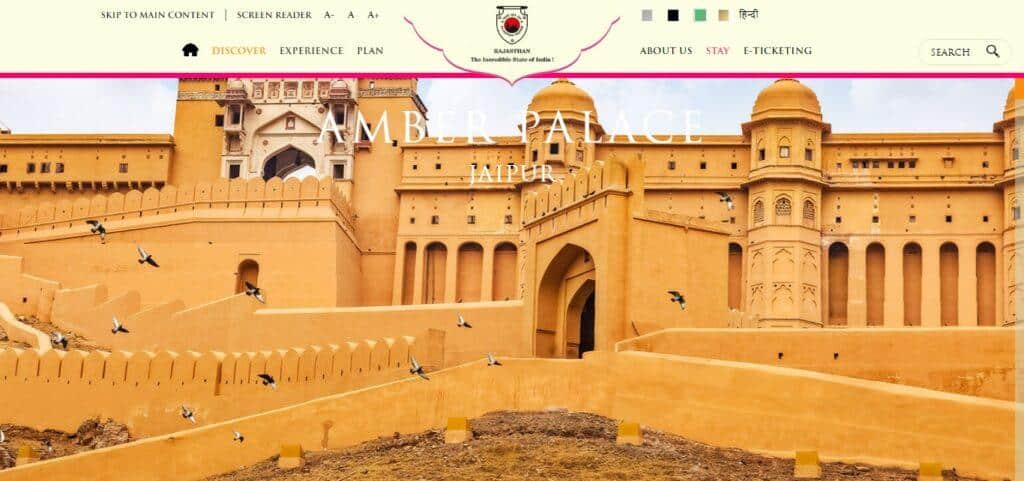
Adding to the regal atmosphere is the option for visitors to climb the fort atop adorned elephants. The stunning scenery is enhanced by the expansive vistas of Maota Lake from the royal ramparts. Within the palace complex are two more architectural wonders: the Diwan-i-Aam, or Hall of Public Audience, and the Diwan-i-Khas, or Hall of Private Audience. The nighttime sound and light show tells the story of the fort’s history and is an engaging experience. Amber Palace transports guests to the era of maharajas and extravagant splendour, serving as a monument to the magnificence of Rajasthan’s royal past.
22.Bhangarh Fort
One of the most fascinating destinations to visit in the state is Bhangarh Fort, which is situated in the Alwar region of Rajasthan on the fringe of the Sariska Tiger Reserve. The monument is shrouded in frightening folklore and alluring mysticism. Constructed by Raja Madho Singh in the 17th century, the fort has a reputation for being among the most haunted locations in India because of the legends surrounding it about curses and paranormal activity. The crumbling buildings, old temples, and overgrown foliage all add to the fort’s eerie, deserted atmosphere. To further add to the mystery surrounding Bhangarh, the Archaeological Survey of India has posted caution signs preventing entry into the fort premises after nightfall and before sunrise.
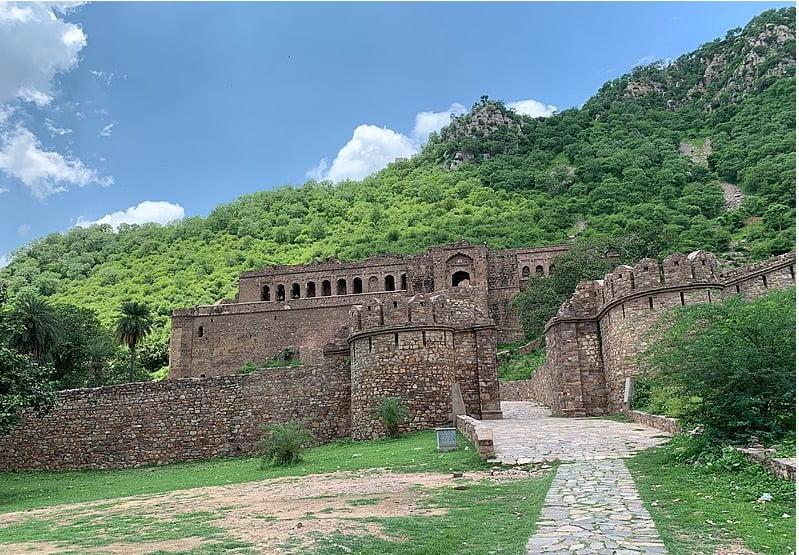
The fort draws adventurers, history buffs, and paranormal enthusiasts despite its reputation for being haunted. Bhangarh Fort is a site that blends historical interest with an element of the occult, offering a unique experience for anyone brave enough to investigate its ghostly history. The surrounding terrain, with its parched hills and ruins, intensifies the spooky mood of the fort.
23.Chittorgarh
An enduring reminder of the Rajputana dynasty’s bravery, legacy, and architectural genius is the ancient city of Chittorgarh in Rajasthan. One of the biggest forts in India and a representation of Rajput pride, Chittorgarh Fort dominates this UNESCO World Heritage Site. Tales of heroic wars and regal magnificence are told through the fort’s enormous walls, elaborate palaces, and towering gates. Within the fort complex, the Vijay Stambh (Victory Tower) and Kirti Stambh (Tower of Fame) are noteworthy for their historical significance and exquisite architecture. The Padmini Palace’s reflecting pool gives the fort’s surroundings a charming romantic feel.

Chittorgarh’s cultural tapestry is further enhanced by the lively Meera Temple and the tranquil Gaumukh Reservoir. The beautiful Kumbhalgarh Fort, which is encircled by the second-longest wall in the world after the Great Wall of China, is another reason for the city’s fame. Chittorgarh is a must-visit location for anyone looking for an in-depth exploration of the region’s royal legacy because it embodies the tenacity and spirit of Rajasthan’s past.
24.Neemrana
Neemrana is a fascinating location in Rajasthan because it offers a distinctive fusion of modern luxury and heritage, nestled between Delhi and Jaipur. The Neemrana Fort Palace, a magnificent 15th-century heritage hotel that has been painstakingly restored to its former splendour, is the main attraction of Neemrana. The fort-palace, which is perched atop a hillside, has magnificent architecture, elaborate murals, and elegant apartments with expansive views of the surroundings. Within the fort complex, visitors can explore the immaculately kept gardens, step wells, and palaces.
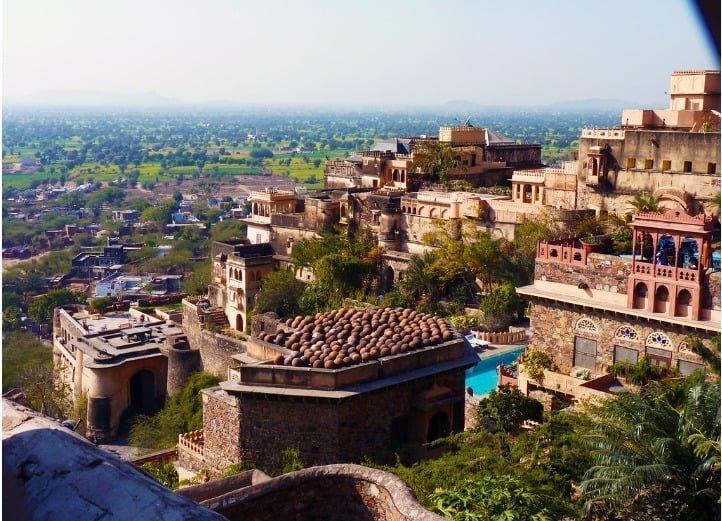
A thrilling adventure that offers a unique view of the old building is zip-lining from the fort. Neemrana provides an insight into rural Rajasthani life as well, since neighbouring villages exhibit customary crafts and ways of life. Other historical treasures in the area include the Kesroli Hill Fort and the ancient step well known as the Baori. Neemrana is a magnificent hideaway that skilfully combines history with contemporary conveniences, as well as a living tribute to Rajasthan’s cultural legacy. It is more than just a place to appreciate the past.
25.Alwar (Best Places To Visit In Rajasthan)
The city of Alwar, which is tucked away in northern Rajasthan, is a melting pot of cultural diversity, history, and scenic beauty. Famous for its magnificent panoramic views of the city below, the historic Alwar Fort, also called Bala Quila, is perched on a high hill. Exquisite palaces and creative embellishments can be found at the City Palace, a magnificent fusion of Rajput and Mughal architectural traditions. Nestled in peaceful surroundings, the Siliserh Lake Palace offers a calm getaway with a touch of history.
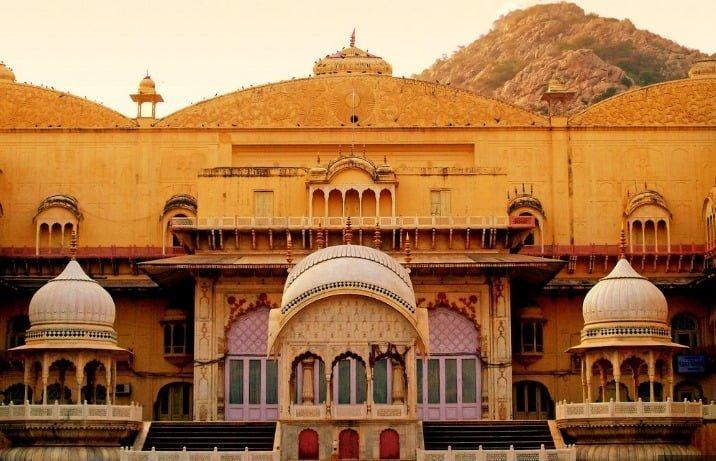
The Sariska Tiger Reserve, a sanctuary for wildlife enthusiasts and a home to Bengal tigers, leopards, and other species, is also located in Alwar. The city is made even more charming by the Moosi Maharani ki Chhatri, a magnificent cenotaph, and the lively local markets. Alwar, surrounded by environmental reserves, has a rich history, impressive architecture, and is a highly attractive location amid Rajasthan’s varied landscape.
26.Kumbhalgarh
With its striking fortress and breathtaking surroundings, Kumbhalgarh, a historical gem in Rajasthan’s rough Aravalli Range, is a sight to behold. At more than 36 kilometres, the Kumbhalgarh Fort, a UNESCO World Heritage Site, has the second-longest continuous wall in the world after the Great Wall of China. The enormous gateways, exquisitely carved palaces, and historic temples inside the fort complex offer a window into the splendour of the Mewar empire. Perched atop the fort, the Badal Mahal is a palace that provides breathtaking sweeping views of the surrounding landscape.
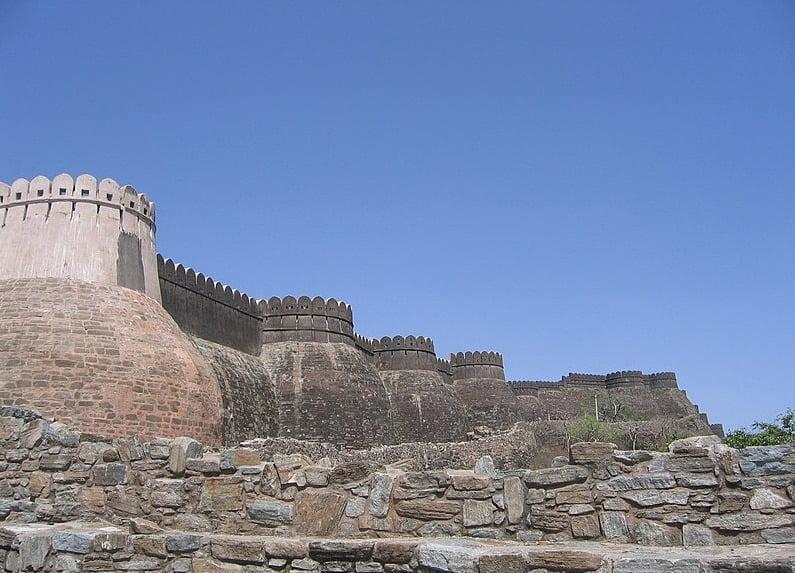
The fort is surrounded by the Kumbhalgarh Wildlife Sanctuary, which is home to a wide variety of flora and animals, including wolves, leopards, and several bird species. Another wonder to see is the Ranakpur Jain Temples, which are nearby Kumbhalgarh and are renowned for their beautiful marble carvings. Kumbhalgarh invites visitors to fully experience Rajasthan’s rich cultural and historical legacy with its historical significance, architectural wonders, and scenic beauty.
27.Shekhawati
The northeastern region of Rajasthan known as Shekhawati, or the “Open-Air Art Gallery,” is well-known for its intricate murals and exquisitely painted havelis, or traditional houses. Shekhawati’s cities and villages are home to an astounding collection of vivid wall paintings that illustrate historical events, mythological stories, and elaborate floral designs. Among the well-known towns in Shekhawati that preserve this distinctive legacy are Nawalgarh, Mandawa, and Fatehpur. The elaborate details and vibrant murals on the havelis take guests back to a time of grandeur and artistic excellence.
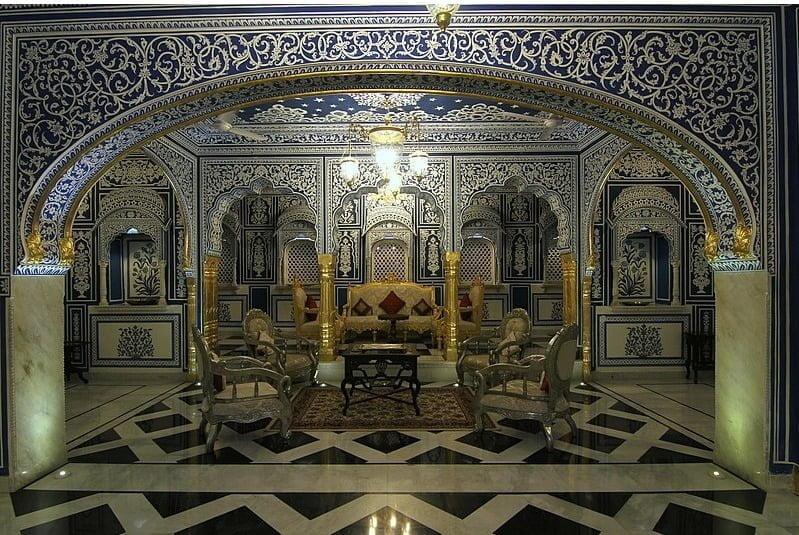
The organised exhibition of artefacts at the Morarka Haveli Museum in Nawalgarh highlights the great cultural diversity of the area. In addition to being a visual feast for art lovers, Shekhawati offers evidence of the wealth and support of the Marwari merchants who commissioned these elaborate paintings for their residences. Discovering Shekhawati is akin to entering a dynamic artwork that narrates the tale of Rajasthan’s creative and cultural heritage.
28.Garadia Mahadev
Near the Rajasthani town of Kota, Garadia Mahadev is a hidden treasure and remarkable natural phenomenon that enthrals tourists with its breathtaking views and tranquil environs. Located on the Chambal River’s banks, Garadia Mahadev provides expansive views of the canyon the river has carved out of the rocky terrain. A modest temple honouring Lord Shiva is located at the location, which gives the natural beauty a spiritual element. A magnificent view of the Chambal River meandering between cliffs and ravines may be seen from the viewpoint at Garadia Mahadev.
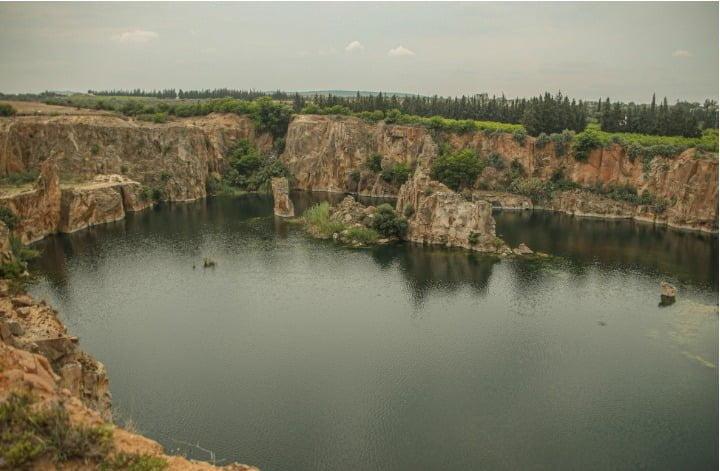
It’s the ideal location for nature enthusiasts and anyone looking for a quiet getaway because of the abundant vegetation and serene ambience. The place is especially well-liked at sunset since the shifting colours of the sky give the surroundings an enchanted feel. In Rajasthan’s varied environment, Garadia Mahadev, with its natural beauty and spiritual atmosphere, is a lesser-known yet intriguing destination.
29.Nathdwara
Nathdwara, a quaint town in the Aravalli hills of Rajasthan, holds significant cultural and religious importance, making it a cherished destination for pilgrims and art enthusiasts alike. The town is renowned for the revered Shrinathji Temple, dedicated to Lord Krishna, which houses a stunning idol believed to be self-manifested. The intricate rituals, festivals, and devotional music add to the spiritual ambiance of the temple. Nathdwara is also celebrated for its Pichwai paintings, exquisite artworks that depict various scenes from Lord Krishna’s life, created with meticulous detailing and vibrant colors.
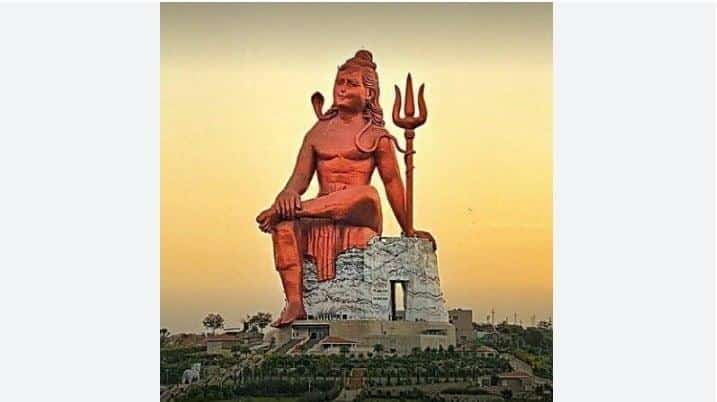
The craftsmanship and artistic heritage of Nathdwara attract connoisseurs from across the world. The town’s picturesque setting on the banks of the Banas River, surrounded by hills, adds to its charm. The Eklingji Temple, dedicated to Lord Shiva, is another sacred site nearby. Nathdwara offers a harmonious blend of spirituality and artistic richness, providing visitors with a unique and immersive experience in the heart of Rajasthan.
30.Fatehpur (Best Places To Visit In Rajasthan)
Fatehpur, a historical town in the Shekhawati region of Rajasthan, stands as a living canvas adorned with intricately painted havelis, grand forts, and bustling bazaars. This architectural treasure trove is renowned for its well-preserved frescoes that adorn the facades of the havelis, showcasing a vibrant array of colors and depicting scenes from mythology, local legends, and everyday life. The havelis of Fatehpur, including the Mahavir Prasad Goenka Haveli and the Nadine Le Prince Haveli, exemplify the opulent merchant culture of the region during the 18th and 19th centuries.
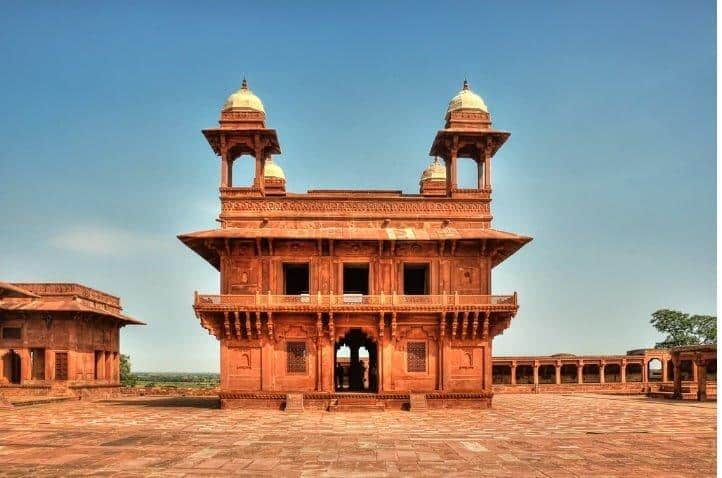
The historic Poddar Haveli Museum, with its exquisite collection of artifacts and paintings, provides further insight into the cultural and artistic heritage of Fatehpur. The town also boasts architectural marvels like the Baggi Khana, a medieval-style stepwell, and the stunning Jain Temples. Fatehpur, with its rich history and artistic grandeur, offers a delightful journey through time for those seeking to explore the lesser-known gems of Rajasthan.
What Qualities Make Rajasthan’s Best Places To Visit Stand Out?
Warmth & Hospitality: The Rajasthani people are renowned for their gracious hospitality, which enhances the vacation experience on a more intimate level. Engaging with locals and lodging in historic hotels adds to the overall experience.
Culinary Delights: Rajasthani food is a culinary joy for tourists, with its distinct flavours and abundant variety. A gastronomic excursion may be had with traditional meals like Dal Baati Churma, Gatte ki Sabzi, and numerous sweets.
Colourful Markets: Bright markets like the Sardar Market in Jodhpur and the Johari Bazaar in Jaipur provide visitors a lovely way to buy for traditional jewellery, handicrafts, and textiles, allowing them to bring a piece of Rajasthan’s rich cultural heritage home.
Forts and Palaces: Ideally positioned atop hills or tucked away by lakes, Rajasthan’s forts and palaces offer sweeping vistas of the surrounding area as well as stunning architectural design, evoking a sense of grandeur and history.
Combination of Tradition and Modernity: Rajasthan has accepted modernity and preserved its rich traditions, resulting in a harmonious combination that gives tourists the best of both worlds.
What Make These Best Places In Ahmedabad?
The largest city in the state of Gujarat and one of India’s fastest-growing cities, Ahmedabad is well-known for its fascinating history, lively culture, and stunning architecture. Some locations in Ahmedabad stand out for a variety of reasons:
Historical Significance: During India’s independence movement, Mahatma Gandhi resided at the Sabarmati Ashram in Ahmedabad. The ashram is a historically significant location that provides insights into the ideology and life of the Father of the Nation.
Wonders of Architecture: The city is home to some amazing buildings, such as the Sidi Saiyyed Mosque, which is renowned for its elaborate stone lattice work, and the Jama Masjid, a mosque dating back to the 15th century with excellent craftsmanship. Another remarkable piece of architecture is the Adalaj Stepwell, an old stepwell with exquisite carvings.
Gandhi Nagar: Gandhinagar, the capital of Gujarat, is renowned for its well-planned design, which includes broad highways and green areas. Gandhinagar is situated close to Ahmedabad. A popular tourist destination and stunning architectural feat is Gandhinagar’s Akshardham Temple.
Manek Chowk: This busy square is a nighttime haven for street food enthusiasts, turning from a vegetable market in the morning. Manek Chowk is well-known for its mouthwatering street cuisine, snacks, and a wide range of regional specialities that draw in both residents and visitors.
Kankaria Lake: Kankaria Lake is a well-liked recreational area that provides a variety of activities, an amusement park, and a beautiful environment with a circular pathway. A colourful cultural festival called the Kankaria Carnival is also held on the lakeside.
Calico Museum of Textiles: The museum features an amazing collection of Indian fabrics, costumes, and handicrafts that spans centuries, making it a veritable gold mine for art and history buffs.
Why Should You Look Best Places To Visit In Rajasthan?
Discovering Rajasthan’s top tourist destinations is fascinating and enlightening for a number of strong reasons. First of all, the state serves as a living reminder of India’s regal past, and its magnificent forts and palaces highlight the opulence of Rajput kings. Witnessing colourful festivals, folk dances, and traditional art forms is one way that visitors can experience Rajasthan’s diverse culture and customs.
Furthermore, Rajasthan’s varied landscapes add to its attraction. The state offers a diverse and beautiful landscape, ranging from the golden saonds of the Thar Desert in Jaisalmer to the tranquil lakes of Udaipur and the verdant surroundings of Mount Abu. Like Ranthambore National Park, the wildlife sanctuaries provide exhilarating wildlife safaris and the chance to see elusive animals, like the majestic Bengal tiger.
The opportunity to enjoy Rajasthan’s delicious food, which is renowned for its rich flavours and variety, as well as its kind hospitality, add even more to the whole experience. Rajasthan invites visitors with a distinctive fusion of history, culture, and natural beauty, making it a location that truly catches the imagination. Whether it’s visiting old markets, strolling through historic cities, or taking part in local festivals
Conclusion Best Places To Visit In Rajasthan?
In summary, discovering Rajasthan’s top locations is a captivating voyage that reveals the intricate web of India’s cultural legacy, royal past, and varied topography. Rajasthan enthrals tourists with its abundant attractions, which range from the majestic Pink City of Jaipur to the tranquil lakes of Udaipur, the golden sands of Jaisalmer, and the wildlife sanctuaries like Ranthambore. Rajput monarchs’ richness is on display in the architectural wonders of forts and palaces, each of which tells a story of bravery and majesty. The experience is further enhanced by the state’s colourful festivals, friendly people, and mouthwatering food.
Rajasthan provides an immersive and varied experience, making it a destination that is in tune with history, customs, and the natural world. Activities include animal safaris, touring busy markets, and taking part in traditional celebrations. This area of contrasts and colours welcomes travellers to travel back in time while embracing the lively energy that characterises Rajasthan in the present day.
FAQ Best Places To Visit In Rajasthan
What are the must-visit cities in Rajasthan?
Rajasthan is home to several iconic cities, including Jaipur (the Pink City), Jodhpur (the Blue City), Udaipur (the City of Lakes), and Jaisalmer (the Golden City), each offering unique cultural and historical attractions.
What are the top historical attractions in Rajasthan?
Rajasthan is rich in historical landmarks, such as the Hawa Mahal, City Palace, and Amber Fort in Jaipur, Mehrangarh Fort in Jodhpur, and the stunning Lake Palace in Udaipur.
Are there any wildlife sanctuaries in Rajasthan?
Yes, Ranthambore National Park is a renowned wildlife sanctuary in Rajasthan, famous for its tiger population. It offers wildlife safaris and the opportunity to spot various other species.
What is the best time to visit Rajasthan?
The best time to visit Rajasthan is during the winter months, from October to March, when the weather is pleasant and suitable for exploring the outdoor attractions.
What cultural experiences can one have in Rajasthan?
Rajasthan offers a plethora of cultural experiences, including attending traditional Rajasthani folk dances, exploring local markets, participating in colorful festivals like the Pushkar Camel Fair, and visiting historic palaces that often host cultural events.
